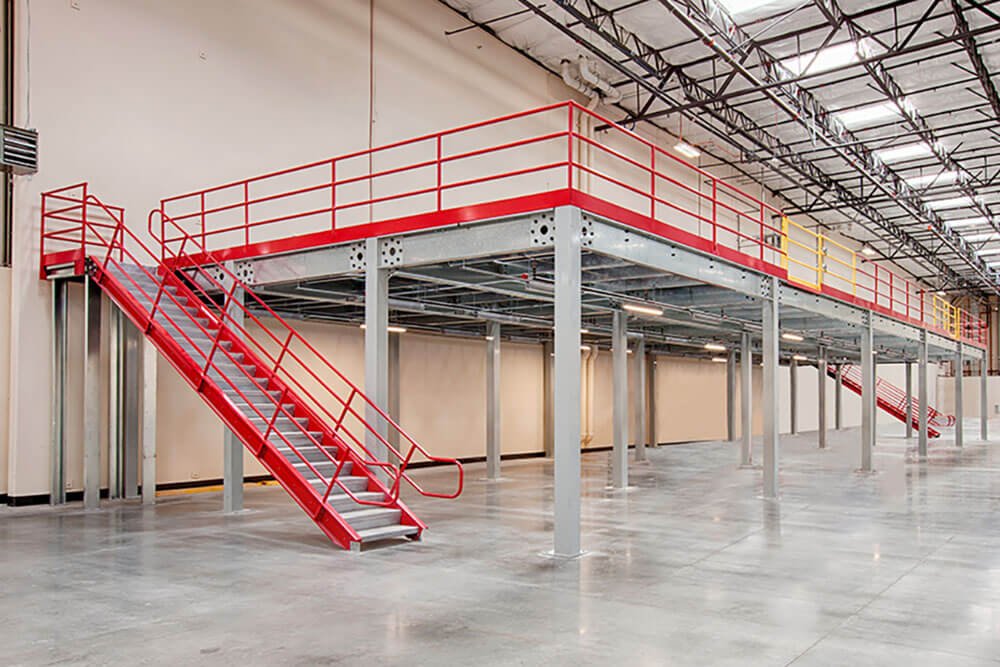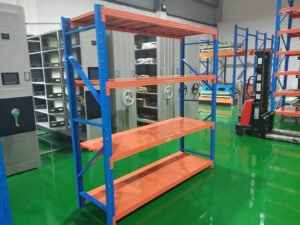Mezzanine floors offer great efficiency to maximize space and have an added area where you can store your stuff and even make an office, lounge, or anything else. However, when it comes to having a mezzanine floor, the first thing to do is to create a mezzanine floor plan. If you want to learn more about planning the mezzanine floor, this guide below can help you.
What is a Mezzanine Floor Plan?
Definition of a Mezzanine Floor Plan:
The mezzanine level floor plan consists of a layout of constructing a mezzanine floor which is quite detailed. It comprises many design aspects like materials, load capacity, dimensions, and even the accessibility of the mezzanine floor. Mezzanines are mostly opted in factories, warehouses, and retail stores so that an additional space can be created. Some of the aspects of the mezzanine floor plan drawing are as follows:
- It comprises a design and location where the supports and columns will be placed.
- The load that the floor can hold will be assessed in the mezzanine floor plan drawing.
- Point of accessibility which is either stairs or elevators.
- Safety exits, barriers, handrails.
- The lighting and utility solutions like HVAC and lighting installation.
Mezzanine floor plan drawing plays a vital role in the construction of a mezzanine floor plan. It provides the contractor with a guide and even ensures that the space is built taking into consideration the regulatory standards.
Benefits of Mezzanine Floor Planning:
Mezzanine floor planning offers various benefits some of these are as follows:
- The mezzanine floor offers a chance to use the vertical space in a better way.
- It is a cost-effective solution because expansion to a new structure could be expensive.
- It is flexible and can be used as an added workspace or just a storage solution.
- It enhances the workflow and reduces inefficiencies.
Mezzanine Floor Plan with Dimensions
Mezzanine floor building requires very careful planning and the most important consideration here is designing the mezzanine floor plan with dimensions. The section below highlights the essential aspects associated.
How to Measure and Define Dimensions:
When it comes to measuring the space for the mezzanine floor plan first you will have to determine the ceiling height and the floor area. Measure the width, length, and height and ensure that you have sufficient space vertically which will be enough above and below the mezzanine floor. Also, consider access points and existing structures when measuring the dimensions.
Standard Dimensions for Mezzanine Floors:
The mezzanine’s total area in a room cannot be larger than one-third of the room size. The height of the mezzanine is at its minimum of 14.7 between the ceiling and the ground floor. This means that below and above the mezzanine the standard height should be at least 7 feet not less than this.
Tips for Customizing Dimensions:
When you are customizing the mezzanine floor plan make sure that the dimensions meet your needs. In cases where the mezzanine is used for heavy equipment the load capacity should be accordingly chosen and the right floor thickness should be chosen.
Similarly, incorporate flexible access points like staircases and lifts and adjust the height so that they can be used without any hassle. The mezzanine floor should have the right lighting and accessibility.
Creating a Mezzanine Floor Plan Drawing
When creating a mezzanine floor plan drawing some of the important things to consider in your design are as follows:
Step-by-Step Guide to Drawing a Mezzanine Floor Plan:
When creating a mezzanine floor plan drawing the step-by-step guide for it is given below:
- Gather the required tools like graph paper, pencil, and ruler or you can also use software that creates a mezzanine floor plan 3D design.
- Measure the space where you want to make the mezzanine and note down the height of the ceiling, the width, and the length of the space.
- Determine the scale for measurements like 1 inch is 10 feet so that you can have your plan reflected in real-world emolument.
- Start sketching the floor base featuring windows and doors.
- Design the layout of the mezzanine and its level, and also mention the access points.
- Make sure that your design of the mezzanine complies with safety and accessibility standards.
Including Important Elements:
The mezzanine floor plan should have all the initial structural components incorporated. You need to point out the columns and load-bearing walls that will support the mezzanine floor. The placement of ladders and stairs should be highlighted and they must comply with the safety standards.
Incorporating guardrails on the edges which are open and placement of HVAC and lighting is also an essential consideration in the plan.
How to Draw a Mezzanine Floor Plan for Different Spaces:
You can draw the different mezzanine floor plans for different spaces and some of the ways you can do this are given below:
- When you are drawing a mezzanine floor plan for a warehouse the main purpose is to enhance the workflow and maximize the storage. In this case, you must have sufficient clearance so that conveyors and forklifts may work, the shelving units also need to be customizable.
- In the case of residential spaces, as much as the purpose is important, the aesthetics cannot be compromised. Make sure to use the materials which match your interior and the mezzanine should have sufficient headroom to allow the space to be usable.
- In offices, the aim of a mezzanine floor is comfort and efficiency. You can incorporate lifts and stairs and also create meeting rooms, workstations, and some storage space. However, ensure that ventilation and lighting are present.
Designing a Mezzanine Floor Plan in 3D
Designing a mezzanine floor plan in 3D is equipped with multiple benefits and some of the important things you must know about it will be discussed in the section below.
Benefits of 3D Visualization:
3D mezzanine floor plans offer a clear and realistic image of the design from different angles. Some of the benefits it offers are as follows:
- It features a realistic image of how the mezzanine would look and what changes would the space around it undergo.
- The issues of lighting, access, and clearance can be assessed before starting the construction.
- Helps to make informed decisions regarding the layout and the material to be incorporated.
- It will help assess the flow of movement and load-bearing capacity on the mezzanine.
Tools and Software for 3D Designs:
Different types of software can be opted for designing the mezzanine floor plans in 3D and some of these are discussed below:
- SketchUp: It offers a wide range of models that can be used for references and is very easy to use. It is suitable for everyone, be they professionals or beginners.
- AutoCAD 3D: It is an advanced software that offers technical control over designs with precision and is mostly opted for by architects.
- Revit: It is a software that is suitable for larger projects and along with 3D designs offers project management features.
- Blender: It is a high-quality open-source software that offers presentation as well as visualization.
Creating Realistic 3D Models:
You can create a 3D design of your mezzanine floor plan by using the right software. Input the measurements of the mezzanine floor plan in the software and allow the software to offer you realistic visuals. You will access various features like different surfaces for the floors, lighting, furniture placement, accessibility, and much more.
Mezzanine Floor Plan and Elevation
When designing the mezzanine floor, plan elevation is also considerable in your drawings.
Understanding Mezzanine Floor Elevations:
Mezzanine floor elevations are very important for the purpose of visualizing the structure and height of the mezzanine in addition to the rest of the space. Elevation gives the vertical dimension and how the mezzanine will blend in with the existing structural elements like walls and columns.
The elevation offers an insight into the access points, heights, and how the mezzanine blends perfectly into the given space. It also ensures that the mezzanine plan meets the code of safety.
Creating Accurate Elevation Drawings:
To make accurate drawings of elevations some of the steps you can take are as follows:
- Measure and note down the space in terms of height which is available between the floor to the ceiling.
- Determine a scale with an accurate ratio that will represent your drawing and real-time scale mapping.
- Sketch the ground floor and the mezzanine floor and make the beams and walls.
- In the design add the guardrails, doors, windows, safety precautions, and stairs.
- Make sure that the elevation meets the load-bearing requirements.
Elevation in Various Settings:
The elevation in different settings has different requirements as given below:
- In a residential space, the mezzanine height are low and they are more inclined towards comfort and aesthetics. Hence, the design would be more on the side of incorporating materials and staircases that match the rest of the design.
- Commercial spaces like offices or retail stores take into consideration public accessibility and hence they have to ensure that the seating areas and storage areas in a mezzanine are visible.
- Industrial mezzanine elevations are mostly inclined towards strength and load capacity. High ceilings and good quality materials like steel beams and gratings are incorporated so that heavy equipment can be handled.
Mezzanine Floor Plan and Section
The mezzanine floor plan and section comprise understanding the cross-sectional view of the mezzanine and incorporating it in the drawing. Some important aspects of it are discussed below.
What is a Mezzanine Floor Section?:
The mezzanine floor section is the cross-sectional view of the structure of the mezzanine floor which shows the internal details. The drawing of this section helps to visualize how the mezzanine would look from the inside.
How to Create a Sectional Drawing:
- First, decide on the section line like the vertical cut to reveal the structural elements of the mezzanine floor.
- Select the scale that represents the ratio of scale to real-world map.
- Make the drawing of all the structural aspects like the thickness of the floor, beams, and staircase.
- Specify the headroom, lighting fixtures, and handrails.
Importance of Sectional Views:
The sectional drawings are very important for understanding the way every element in the mezzanine works together. It gives an analysis of load-bearing components and provides an idea of whether the design meets the safety codes or not. This sectional drawing improves the overall process of constructing a mezzanine floor.
Planning a Mezzanine Level Floor Plan for Different Uses
Mezzanine floors are versatile and not limited to certain types of uses. They can be used in commercial, industrial as well as residential spaces. The concept of the mezzanine floor plans for the different uses is discussed here.
Industrial Mezzanine Floor Plans:
Industrial mezzanine floor plans are designed keeping in mind the concept of enhancing the storage capacity and designing a plan that meets the operational needs.
These mezzanine plans would consist of considering having heavy-duty metal incorporated which can handle heavy loads. The plan would also take into consideration the movement of forklifts for easy accessibility of the products.
Commercial Mezzanine Floor Plans:
Commercial mezzanine floor plans are opted in retail shops or offices. The main concept of mezzanine floors in these spaces is to create a workspace, display sections, or extra seating space.
The design of the mezzanine floor should be aesthetic as well as functional. Some modern touch should be added by opting for the right lighting and ventilation and incorporating glass partitions.
Residential Mezzanine Floor Plans:
Residential mezzanine floors make use of vertical space in homes and apartments and create small living areas, home offices, or even small bedrooms. The design choices for such a mezzanine floor plan consist of choosing delicate and aesthetically pleasing elements.
Lightweight materials and such interior is chosen which matches with the rest of the house. These mezzanines are designed to be airy, open, and comfortable.
Tips for Designing and Drawing Mezzanine Floor Plans
When designing and drawing mezzanine floor plans some of the tips that may prove to be helpful are as follows:
Choosing the Right Materials:
The design of the mezzanine floor plan will require considering the right materials which make the structure of the mezzanine durable and strength-oriented. Steel is very commonly opted for industrial mezzanine and wood is suitable for commercial use. However, if a soundproof and stable option is needed the concrete could be a better choice.
Structural Safety and Load Capacity:
It is important to ensure that your mezzanine floor design plan considers the load-bearing capacity and complies with the safety code. The industrial mezzanine must be manufactured with the idea of heavy loads in mind so that the structure supports heavy loads and equipment. Apart from this incorporating guardrails and beams is also significant.
Compliance with Building Codes:
Building codes and safety adherence are also mandatory to be followed when designing a mezzanine floor. Some of the important considerations in this regard are fire safety, minimum ceiling, and structural integrity. Emergency exits, sprinkles, smoke alarms, and safety rails are crucial.
Common Mistakes to Avoid When Planning a Mezzanine Floor
The common mistakes that must be avoided when planning a mezzanine floor are as follows:
Design Flaws:
Do not overlook the dimensions and space allocation. It is very important to have the right space between the mezzanine and ceiling so that the space can be utilized properly. Similarly, the access points must be positioned in a way that enhances the operation efficiency. The layout of the mezzanine must be meant to make the best use of space and ensure easy access.
Structural Issues:
The lack of load-bearing assessment is also a major mistake in the mezzanine floor plan design. The support required to handle the weight cannot be ignored and it could be people, products, or machinery. Structure failure always leads to a disastrous situation.
Ignoring Aesthetic Details:
The aesthetics of the mezzanine should not be taken lightly. It is very important for the mezzanine to be visually appealing and the right lighting, material, flooring, and integration of everything is very crucial.
Conclusion
Designing a mezzanine floor plan requires sufficient knowledge and skills and when you are looking to have it designed we at Lracking are the experts. You can get in touch with us and we’ll use our expertise and experience to help you build a very well-ventilated, spacious, accessible, and balanced mezzanine floor plan.




